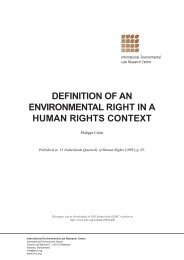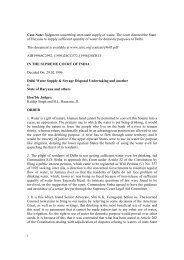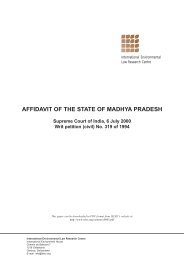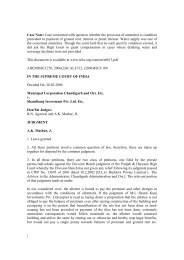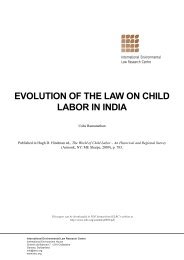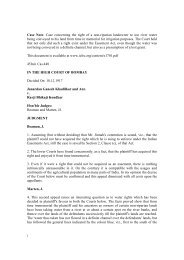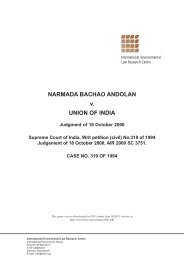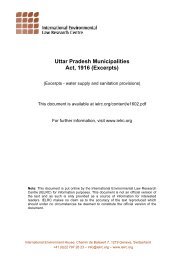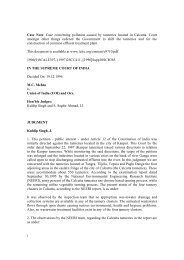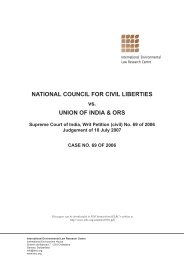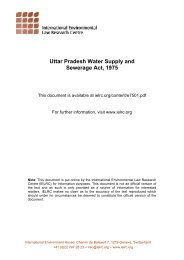Mullaperiyar Environmental Protection Forum v. Union of India (UOI)
Mullaperiyar Environmental Protection Forum v. Union of India (UOI)
Mullaperiyar Environmental Protection Forum v. Union of India (UOI)
- No tags were found...
Create successful ePaper yourself
Turn your PDF publications into a flip-book with our unique Google optimized e-Paper software.
The Committee will visit the dam to have first hand information and to assess the safetyaspects <strong>of</strong> the dam. It will hold discussions with Secretary, Irrigation <strong>of</strong> the Kerala Govt.as well as Secretary, PWD, Govt. <strong>of</strong> Tamil Nadu with respect to safety <strong>of</strong> the dam andother related issues.10. According to the State <strong>of</strong> Tamil Nadu, the Committee after inspecting the dam andafter holding discussions with the <strong>of</strong>ficials <strong>of</strong> the two States, submitted its interim reportwherein recommendations were made as under:1. The Tamil Nadu PWD Department should immediately test the masonry <strong>of</strong> the Babydam to find out the permissible tensile strength that can be adopted for the lime surkhymortar used in the construction <strong>of</strong> Baby dam. Central Soil and Materials Research Station(CSMRS), Government <strong>of</strong> <strong>India</strong>, New Delhi, should carry out these tests. CSMRS arespecialist in carrying out geophysical and core tests and have a good reputation. Thesetests should be carried out in the presence <strong>of</strong> the representatives <strong>of</strong> Tamil Nadu PWD,Irrigation Department, Government <strong>of</strong> Kerala and CWC. The results <strong>of</strong> these tests shouldbe made available to the Committee by end <strong>of</strong> November, 2000. The Government <strong>of</strong>Kerala should permit Tamil Nadu PWD & CSMRS to carry out these tests without anyhindrance.2. Core samples <strong>of</strong> Baby dam shall also be extracted and tested by CSMRS, New Delhi,at the upstream and downstream faces <strong>of</strong> the dam. These results may be used to developco- relation between the actual tests and the results obtained by geophysical testing.3. The strengthening measures pertaining to the Baby dam and the earthen bund asalready suggested by the CWC and formulated by the Government <strong>of</strong> Tamil Nadu shouldbe carried out at the earliest. Government <strong>of</strong> Kerala is requested to allow the execution <strong>of</strong>strengthening measures <strong>of</strong> the Baby dam and earthen bund immediately.4. Raising <strong>of</strong> water level beyond 136 ft. (41.45 m) will be decided after obtaining thetensile and compressive strength <strong>of</strong> the masonry <strong>of</strong> the Baby dam.11. The final report <strong>of</strong> the committee shows that certain more steps were required to betaken before raising <strong>of</strong> reservoir level upto FLR i.e. 152 feet and those recommendationsare:1. The strengthening measures pertaining to Baby dam and the earthen bund, as alreadysuggested by CWC and formulated by the Government <strong>of</strong> Tamil Nadu, should be carriedout at the earliest.2. Government <strong>of</strong> Kerala should allow the execution <strong>of</strong> strengthening measures <strong>of</strong> Babydam, earthen bund and the remaining portion <strong>of</strong> about 20 m <strong>of</strong> parapet wall on the mainMulla Periyar Dam upto EL 160 ft. (48.77 m) immediately.3. CWC will finalise the instrumentation for installation at the main dam. In addition,instruments will be installed during strengthening <strong>of</strong> Baby dam, including the earthen4
und, so that monitoring <strong>of</strong> the health <strong>of</strong> Mulla Periyar dam, Baby dam and earthen bundcan be done on a continuous basis.4. The water level in the Mulla Periyar reservoir be raised to a level where the tensilestress in the Baby dam does not exceed 2.85 t/m2 (as suggested by Shri ParameswaranNair, Kerala representative) especially in condition E (full reservoir level withearthquake) as per BIS Code IS 6512-1984 with ah= 0.12 g and analysis as per clauseNos. 3.4.2.3 and 7.3.1 <strong>of</strong> BIS Code 1893-1984.5. The Committee Members discussed the issue <strong>of</strong> raising <strong>of</strong> water level above EL 136.00ft. (41.45 m) after studying the analysis <strong>of</strong> safety <strong>of</strong> Baby dam. Pr<strong>of</strong>. A. Mohanakrishnan,Member <strong>of</strong> Tamil Nadu Government, opined in the light <strong>of</strong> para 4 that the water levelshould be raised upto at least EL 143.00 ft. (43.59 m) as the tensile stresses are within thepermissible limits. Shri M.K. Parameswaran Nair, Member <strong>of</strong> Kerala Government did notagree to raise the water level above EL 136.00 ft. (41.45 m). However, the Committeeafter detailed deliberations, has opined that the water level in the Mulla Periyar reservoirbe raised to EL 142.00 ft. (43.28 m) which will not endanger the safety <strong>of</strong> the Main dam,including spillway, Baby dam and earthen bund. The abstracts <strong>of</strong> the calculations forstress analysis are enclosed as Annex. XIX.6. This raising <strong>of</strong> reservoir level upto a level where the tensile stress does not exceed 2.85t/m2 during the earthquake condition is an interim measure and further raising <strong>of</strong> waterlevel to the FRL EL 152.00 ft. (46.33 m) [original design FRL <strong>of</strong> the Mulla PeriyarReservoir] be studied after the strengthening measures on Baby dam are carried out andcompleted.12. The State <strong>of</strong> Kerala continued to resist raising <strong>of</strong> water level. The objections raised bythe representative <strong>of</strong> State <strong>of</strong> Kerala were considered by the Expert Committee and takinginto account the matter in its entirety and keeping in view the safety <strong>of</strong> dam, certainsuggestions were made. It required the State <strong>of</strong> Tamil Nadu to take those steps. TheExpert Committee stated that it was equally obligatory on the part <strong>of</strong> State <strong>of</strong> Kerala toact in accordance with the suggestions and recommendations made by the CWC and thatthe State <strong>of</strong> Kerala cannot refuse to cooperate on the ground that raising <strong>of</strong> water levelwould cause serious problem in spite <strong>of</strong> the report <strong>of</strong> the Expert Committee andrecommendations and decision by CWC.13. In the writ petition filed by <strong>Mullaperiyar</strong> <strong>Environmental</strong> <strong>Protection</strong> <strong>Forum</strong>, variousprayers have been made. They have, inter alia, prayed that agreements <strong>of</strong> 1886 and 1970be declared as null and void and consequential relief be granted and also that Section 108<strong>of</strong> the States Re-organisation Act, 1956, be declared ultra vires and unconstitutional as itencroaches upon legislative domain <strong>of</strong> the State Legislature under Entry 17 <strong>of</strong> List II <strong>of</strong>the Seventh Schedule <strong>of</strong> the Constitution <strong>of</strong> <strong>India</strong>.14. The petitioner has also raised objection about the legality <strong>of</strong> the agreement betweenthe Maharaja <strong>of</strong> Travancore and the Governor General. It is claimed that the agreementwas entered into in 'unholy' haste and virtually it was thrust upon and the Maharaja was5
forced to accept it. It was also submitted that under Section 108 <strong>of</strong> the States ReorganizationAct, any agreement or arrangement entered into by Central Government andone or more existing States relating to the right to receive and utilize water can continueto remain in force subject to certain adaptations and modifications as may be agreed uponbetween the successor States. Since there was no such agreement after November 1,1957, the agreement would not continue to remain in force. It also pleaded that theagreements are not covered by Entry 56 <strong>of</strong> List I <strong>of</strong> Seventh Schedule <strong>of</strong> the Constitution<strong>of</strong> <strong>India</strong> and hence Parliament has no power to make any law in respect there<strong>of</strong>.15. On the other hand, the State <strong>of</strong> Taml Nadu seeks directions for raising <strong>of</strong> water levelto 142 ft. and later, after strengthening, to its full level <strong>of</strong> 152 ft. On Section 108 <strong>of</strong> theStates Reorganisation Act, the stand taken by the State <strong>of</strong> Tamil Nadu is that this Section,in pith and substance, deals with "continuance <strong>of</strong> agreements and arrangements relatingto certain irrigation, power or multipurpose projects" and it figures in the Act underwhich the present State <strong>of</strong> Kerala was formed.16. According to the State <strong>of</strong> Tamil Nadu, the Act was not an enactment made in exercise<strong>of</strong> Parliament's legislative power under Entry 56 <strong>of</strong> List I, but was an enactment coveredby Articles 3 & 4 <strong>of</strong> the Constitution <strong>of</strong> <strong>India</strong> which provides for formation <strong>of</strong> new Statesand making <strong>of</strong> supplemental, incidental and consequential provisions. The pre-existingcontractual obligation was reasserted and reaffirmed by the State <strong>of</strong> Kerala after itsformation by signing fresh agreements in 1970. It is also urged that the Lists in ScheduleSeven have no applicability as the point in issue is governed by Articles 3 & 4 <strong>of</strong> theConstitution <strong>of</strong> <strong>India</strong>.17. Another contention urged for the petitioner is that in the light <strong>of</strong> later development <strong>of</strong>law, the agreement <strong>of</strong> 1886 stands frustrated. It was submitted that the lease land wasdeclared as reserve forest in the year 1899 by the erstwhile State <strong>of</strong> Travancore under theTravancore Forest Act. The notification remained in force under Sub-section (3) <strong>of</strong>Section 85 <strong>of</strong> the Kerala Forest Act, 1961. In 1934, Periyar Wildlife Sanctuary had beendeclared as a 'sanctuary' covering the grassy area, marshy areas, swamps <strong>of</strong> <strong>Mullaperiyar</strong>Dam which was expanded to 777 sq. kms. under the Wild Life <strong>Protection</strong> Act, 1972.Taking into account its importance as a well known habitat <strong>of</strong> tigers which is a highlyendangered species, the sanctuary has been declared as "Periyar Tiger Reserve" in 1978under the special management programme known as 'Project Tiger'. It was said to be theoldest sanctuary in the State <strong>of</strong> Kerala which played a very important role in bio-diversityconservation in Western Ghats. International <strong>Union</strong> for Conservation <strong>of</strong> Nature andNatural Resources (IUCN) has declared it as a bio- diversity hot spot. According to thepetitioner, the forest land immediately above the present maximum water level at 136 feethas special significance from bio-diversity point <strong>of</strong> view as it comprises different types <strong>of</strong>habitats like grassy areas, marshy areas, swamps and areas covered with trees. These arethe prime habitats used by most <strong>of</strong> the wild animals especially larger herbivores,carnivores and amphibians. The birds like darter and cormorants nest on the tree stumpswhich stand out distributed in the reservoir. Raising <strong>of</strong> water level would submerge thesestumps and upset the nesting and reproduction <strong>of</strong> birds. The submergence <strong>of</strong> the forestabove 136 ft. would adversely affect the bio-diversity therein and in the neighbouring6
forests both in terms <strong>of</strong> flora and fauna. Further, it is urged that raising <strong>of</strong> water levelwould also seriously affect the ecology and economy <strong>of</strong> the State <strong>of</strong> Kerala. Havingregard to these developments, the State <strong>of</strong> Tamil Nadu is not entitled to increase the waterlevel.18. According to the State <strong>of</strong> Tamil Nadu, Periyar Project was completed in the year1895. The Declaration <strong>of</strong> area as Reserved Forest was made in 1899. Moreover, thedeclaration has not adversely affected the interest <strong>of</strong> the petitioner or the State <strong>of</strong> Kerala.According to the State <strong>of</strong> Tamil Nadu, the provisions <strong>of</strong> Kerala Forest Act, 1961 and theWild Life <strong>Protection</strong> Act, 1972 have no applicability to the case in hand. It is also urgedthat raising <strong>of</strong> water level in any case would not adversely affect the natural environment.Further, according to the State <strong>of</strong> Tamil Nadu, the submergence <strong>of</strong> land due to raising <strong>of</strong>water level from 136 feet to the designated FRL 152 feet would cover only 11.2 sq. kms.The percentage <strong>of</strong> area that gets submerged is only 1.44% <strong>of</strong> the total area which is verymeager. It was also asserted that the raising <strong>of</strong> water level will not affect Wildlife habitat,on the contrary it would improve the Wildlife habitat. The restoration <strong>of</strong> water level willin no way affect the flora and fauna as alleged nor affect the nesting and reproduction <strong>of</strong>birds. Higher water level will facilitate better environment for flora and fauna to flourishbetter. It will lead to development <strong>of</strong> new flora and fauna and will also act as restingplace for migratory birds and number <strong>of</strong> rare species <strong>of</strong> birds. The increase <strong>of</strong> water levelin the reservoir will also increase tourist attraction and generate more funds for the State<strong>of</strong> Kerala and also result in increase <strong>of</strong> aquatic life and since the fishery rights are withthe State <strong>of</strong> Kerala, it will enable the said State to generate more funds.19. In the aforesaid background, the questions that arise for determination are these:1. Whether Section 108 <strong>of</strong> the States Reorganisation Act, 1956 is unconstitutional?2. Whether the jurisdiction <strong>of</strong> this Court is barred in view <strong>of</strong> Article 262 read withSection 11 <strong>of</strong> the Inter-State Water Disputes Act, 1956?3. Whether Article 363 <strong>of</strong> the Constitution bars the jurisdiction <strong>of</strong> this Court?4. Whether disputes are liable to be referred to Arbitration?5. Whether the raising <strong>of</strong> water level <strong>of</strong> the reservoir from 136 ft. to 142 ft. would resultin jeopardising the safety <strong>of</strong> the people and also degradation <strong>of</strong> environment?1. RE: Validity <strong>of</strong> Section 108 <strong>of</strong> the States Reorganisation Act, 1956 (For short 'theAct').20. The contention urged is that the subject matter <strong>of</strong> water is covered by Entry 17 <strong>of</strong> theState List under the Seventh Schedule <strong>of</strong> the Constitution and, therefore, Section 108which, inter alia, provides that any agreement or arrangement entered into between theCentral Government and one or more existing States or between two or more existingStates relating to distribution <strong>of</strong> benefits, such as the right to receive and utilise water or7
electric power, to be derived as a result <strong>of</strong> the execution <strong>of</strong> such project, which wassubsisting immediately before the appointed day shall continue in force, would be outsidethe legislative competence <strong>of</strong> the Parliament for the same does not fall in List I <strong>of</strong>Seventh Schedule, it falls in List-II. The Act was enacted to provide for thereorganisation <strong>of</strong> the States <strong>of</strong> <strong>India</strong> and for matters connected therewith as stipulated byArticle 3 <strong>of</strong> the Constitution. The said Article, inter alia, provides that the Parliament mayby law form a new State by separation <strong>of</strong> territory from any State or by uniting two ormore States or parts <strong>of</strong> States or by uniting any territory to a part <strong>of</strong> any State. Article 4,inter alia, provides that any law referred to in Article 2 or 3 shall contain such provisionsfor the amendment <strong>of</strong> the First Schedule and the Fourth Schedule <strong>of</strong> the Constitution asmay be necessary to give effect to the provisions <strong>of</strong> the law and may also contain suchsupplemental, incidental and consequential provisions as Parliament may deemnecessary. The creation <strong>of</strong> new States by altering territories and boundaries <strong>of</strong> existingStates is within the exclusive domain <strong>of</strong> Parliament. The law making power underArticles 3 and 4 is paramount and is not subjected to nor fettered by Article 246 and ListsII and III <strong>of</strong> the Seventh Schedule. The Constitution confers supreme and exclusivepower on Parliament under Articles 3 and 4 so that while creating new States byreorganisation, the Parliament may enact provisions for dividing land, water and otherresources; distribute the assets and liabilities <strong>of</strong> predecessor States amongst the newStates; make provisions for contracts and other legal rights and obligations. Theconstitutional validity <strong>of</strong> law made under Articles 3 and 4 cannot be questioned onground <strong>of</strong> lack <strong>of</strong> legislative competence with reference to the lists <strong>of</strong> Seventh Schedule.The new State owes its very existence to the law made by the Parliament. It would beincongruous to say that the provision in an Act which gives birth to a State is ultra vires alegislative entry which the State may operate after it has come into existence. The power<strong>of</strong> the State to enact laws in List II <strong>of</strong> Seventh Schedule are subject to Parliamentarylegislation under Articles 3 and 4. The State cannot claim to have legislative powers oversuch waters which are the subject <strong>of</strong> Inter-State agreement which is continued by aParliamentary enactment, namely, the States Organisation Act, enacted under Articles 3and 4 <strong>of</strong> the Constitution <strong>of</strong> <strong>India</strong>. The effect <strong>of</strong> Section 108 is that the agreementbetween the predecessor States relating to irrigation and power generation etc. wouldcontinue. There is a statutory recognition <strong>of</strong> the contractual rights and liabilities <strong>of</strong> thenew States which cannot be affected unilaterally by any <strong>of</strong> the party States either bylegislation or executive action. The power <strong>of</strong> Parliament to make law under Articles 3and 4 is plenary and traverse over all legislative subjects as are necessary for effectuatinga proper reorganisation <strong>of</strong> the States. We are unable to accept the contention as toinvalidity <strong>of</strong> Section 108 <strong>of</strong> the Act.2. RE: Whether the jurisdiction <strong>of</strong> this Court is barred in view <strong>of</strong> Article 262 read withSection 11 <strong>of</strong> the Inter-State Water Disputes Act, 1956?21. Article 262 provides that Parliament may by law provide for the adjudication <strong>of</strong> anydispute or complaint with respect to the use, distribution or control <strong>of</strong> the waters <strong>of</strong>, or in,any inter-State river or river valley. The jurisdiction <strong>of</strong> the Courts in respect <strong>of</strong> anydispute or complaint referred to in Article 262(1), can be barred by Parliament by makinglaw. The Inter-State Water Disputes Act, 1956 was enacted by Parliament in exercise <strong>of</strong>8
power under Article 262 <strong>of</strong> the Constitution. Section 11 <strong>of</strong> the said Act excludes thejurisdiction <strong>of</strong> Supreme Court in respect <strong>of</strong> a water dispute referred to the Tribunal.Section 2(c) <strong>of</strong> this Act defines 'water dispute'. It, inter alia, means a dispute as to the use,distribution or control <strong>of</strong> the waters <strong>of</strong>, or as to the interpretation or implementation <strong>of</strong>agreement <strong>of</strong> such waters.22. In the present case, however, the dispute is not the one contemplated by Section 2(c)<strong>of</strong> the Act. Dispute between Tamil Nadu and Kerala is not a 'water dispute'. The right <strong>of</strong>Tamil Nadu to divert water from Peryar reservoir to Tamil Nadu for integrated purpose <strong>of</strong>irrigation or to use the water to generate power or for other uses is not in dispute. Thedispute is also not about the lease granted to Tamil Nadu in the year 1886 or aboutsupplementary agreements <strong>of</strong> 1970. It is also not in dispute that the dam always had andstill stands at the height <strong>of</strong> 155 ft. and its design <strong>of</strong> full water level is 152 ft. There wasalso no dispute as to the water level till the year 1979. In 1979, the water level wasbrought down to 136 ft. to facilitate State <strong>of</strong> Tamil Nadu to carryout certain strengtheningmeasures suggested by Central Water Commission (CWC). The main issue now is aboutthe safety <strong>of</strong> the dam on increase <strong>of</strong> the water level to 142 ft. For determining this issue,neither Article 262 <strong>of</strong> the Constitution <strong>of</strong> <strong>India</strong> nor the provisions <strong>of</strong> the Inter-State WaterDispute Act, 1956 have any applicability. There is no substance in the contention thatArticle 262 read with Section 11 <strong>of</strong> the Inter-State Water Disputes Act bars thejurisdiction <strong>of</strong> the court in regard to nature <strong>of</strong> disputes between the two States.3. RE: Whether Article 363 <strong>of</strong> the Constitution bars the jurisdiction <strong>of</strong> this Court?23. The jurisdiction <strong>of</strong> the courts in respect <strong>of</strong> dispute arising out <strong>of</strong> any provision <strong>of</strong> atreaty, agreement, covenant, engagement, sanad or other similar instrument entered intoor executed before the commencement <strong>of</strong> the Constitution is barred in respect <strong>of</strong> mattersand in the manner provided in Article 363 <strong>of</strong> the Constitution <strong>of</strong> <strong>India</strong>. The main reasonfor ouster <strong>of</strong> jurisdiction <strong>of</strong> courts as provided in Article 363 was to make certain class <strong>of</strong>agreements non-justiciable and to prevent the <strong>India</strong>n Rulers from resiling from suchagreements because that would have affected the integrity <strong>of</strong> <strong>India</strong>. The agreement <strong>of</strong> thepresent nature would not come within the purview <strong>of</strong> Article 363. This Article has noapplicability to ordinary agreements such as lease agreements, agreements for use <strong>of</strong> landand water, construction works. These are wholly non-political in nature. The presentdispute is not in respect <strong>of</strong> a right accruing or a liability or obligation arising under anyprovision <strong>of</strong> the Constitution {see Madhav Rao Scindia v. <strong>Union</strong> <strong>of</strong> <strong>India</strong> }24. The contention also runs counter to Section 108 <strong>of</strong> the States Reorganisation Act,which expressly continues the agreement. There is, thus, no merit in this objection aswell.4. RE: Whether disputes are liable to be referred to Arbitration?25. It is contended that the lease deed dated 29th October, 1886 provides that wheneverany dispute or question arises between the Lessor and the Lessee touching upon therights, duties or liabilities <strong>of</strong> either party, it shall be referred to two arbitrators and then to9
an umpire if they differ. This clause was amended in supplementary agreement dated29th May, 1970. Relying on the arbitration agreement, the contention urged on behalf <strong>of</strong>State <strong>of</strong> Kerala is that the parties should be directed to resort to alternate remedy <strong>of</strong>arbitration and discretionary relief in these petitions may not be granted to State <strong>of</strong> TamilNadu. There is no substance in this contention as well. The present dispute is not aboutthe rights, duties and obligations or interpretation <strong>of</strong> any part <strong>of</strong> the agreement. Asalready noted, the controversy herein is whether the water level in the reservoir canpresently be increased to 142 ft. having regard to the safety <strong>of</strong> the dam. The full waterlevel was 152 ft. It was reduced to 136 ft. in 1979. The aspect <strong>of</strong> increase <strong>of</strong> water level isdependant upon the safety <strong>of</strong> the dam after strengthening steps have been taken. Thisaspect has been examined by experts.5. Re: Whether the raising <strong>of</strong> water level <strong>of</strong> the reservoir from 136 ft. to 142 ft. wouldresult in jeopardising the safety <strong>of</strong> the people and also degradation <strong>of</strong> environment?26. Opposing the increase <strong>of</strong> water level, the contention urged is that it would result in alarger area coming in submergence which is not permissible without complying with themandatory provisions <strong>of</strong> the Forest (Conservation) Act, 1980 and the Wild Life(<strong>Protection</strong>) Act, 1972.27. Reliance has been placed on Section 26A <strong>of</strong> the Wild Life (<strong>Protection</strong>) Act whichstipulates that the boundaries <strong>of</strong> a sanctuary shall not be altered except on arecommendation <strong>of</strong> the National Board constituted under Section 5-A <strong>of</strong> the Act. Thetotal area <strong>of</strong> the sanctuary is about 777 square kilometers. The leased area <strong>of</strong> about 8,000acres is a part <strong>of</strong> the total area. By raising the water level, the boundaries <strong>of</strong> the sanctuarydo not get altered. The total area <strong>of</strong> the sanctuary remains 777 square kilometers. Further,Section 2(17) <strong>of</strong> the Act, which defines land includes canals, creeks and other waterchannels, reservoirs, rivers, streams and lakes, whether artificial or natural, marshes andwetlands and also includes boulders and rocks. It cannot be said that forest or wildlifewould be affected by carrying out strengthening works and increase <strong>of</strong> the water level.On the facts and circumstances <strong>of</strong> the case, the strengthening work <strong>of</strong> existing dam in theforest cannot be described as a non-forestry activity so as to attract Section 2 <strong>of</strong> the Forest(Conservation) Act, 1980, requiring prior approval <strong>of</strong> <strong>Union</strong> <strong>of</strong> <strong>India</strong>.28. As already noticed, it was only in 1979 that the water level was brought down to 136ft from 152 ft. The increase <strong>of</strong> water level will not affect the flora and fauna. In fact, thereports placed on record show that there will be improvement in the environment. It is onrecord that the fauna, particularly, elephant herds and the tigers will be happier when thewater level slowly rises to touch the forest line. In nature, all birds and animals love waterspread and exhibit their exuberant pleasure with heavy rains filling the reservoir resultingin lot <strong>of</strong> greenery and ecological environment around. The Expert Committee hasreported that it will be beneficial for the Wildlife in the surrounding area as it willincrease the carrying capacity for wildlife like elephants, ungulates and in turn tigers. Theapprehension regarding adverse impact on environment and ecology have been found bythe experts to be unfounded. We are also unable to accept the contention that the impacton environments has not been examined. Report dated 28th January, 2003 states that10
there is no adverse impact on the environment. Similarly, the report dated 21st April,2003 is also to the similar effect. It, inter alia, states that:The most productive habitats in terms <strong>of</strong> forage availability to ungulates and elephantsare these vayals. This habitat is <strong>of</strong> even greater significance to wildlife since the greenflush <strong>of</strong> protein rich grasses appears at a time when nutritive quality <strong>of</strong> forest forage islowest. This is so since water is likely to be released from the Dam during the dry monthsfor irrigation. Thus, this nutrient rich biomass is critical for maintaining condition <strong>of</strong>herbivores and their populations during the pinch period.If the lowest water level even after increasing the water capacity <strong>of</strong> the dam is maintainedat the current level, then the increased high water table will make more area available asVayals, effectively adding some more area to the existing Vayals, thereby increasing thecarrying capacity <strong>of</strong> the reserve for ungulates, elephants and in turn <strong>of</strong> tigers.In this view, we find no substance in the contention that there will be adverse effect onenvironment.29. Regarding the issue as to the safety <strong>of</strong> the dam on water level being raised to 142 ft.from the present level <strong>of</strong> 136 ft, the various reports have examined the safety angle indepth including the viewpoint <strong>of</strong> earthquake resistance. The apprehensions have beenfound to be baseless. In fact, the reports suggest an obstructionist attitude on the part <strong>of</strong>State <strong>of</strong> Kerala. The Expert Committee was comprised <strong>of</strong> independent <strong>of</strong>ficers. Seismicforces as per the provisions were taken into account and structural designs madeaccordingly while carrying out strengthening measures. The final report <strong>of</strong> theCommittee, set up by Ministry <strong>of</strong> Water Resources, Government <strong>of</strong> <strong>India</strong> to study thewater safety aspect <strong>of</strong> the dam and raising the water level has examined the matter indetail. The Chairman <strong>of</strong> the Committee was a Member (D&R) <strong>of</strong> Central WaterCommission, two Chief Engineers <strong>of</strong> Central Water Commission, Director, dam safety,Government <strong>of</strong> Madhya Pradesh and retired Engineer-in-Chief, UP besides tworepresentatives <strong>of</strong> Governments <strong>of</strong> Tamil Nadu and Kerala, were members <strong>of</strong> theCommittee. All appended their signatures except the representative <strong>of</strong> the KeralaGovernment. The summary <strong>of</strong> results <strong>of</strong> stability analysis <strong>of</strong> <strong>Mullaperiyar</strong> Baby Damcontains note which shows that the permissible tensile strength was masonry as per thespecifications mentioned therein based on test conducted by CSMRS, Delhi on the timeand agreed by all Committee members including the Kerala representative in the meeting<strong>of</strong> the Committee held on 9-10th February, 2001. It also shows the various strengtheningmeasures suggested by CWC having been completed by Tamil Nadu PWD on the damincluding providing <strong>of</strong> RCC backing to the dam. The report also suggests that the parapetwall <strong>of</strong> the baby dam and main dam have been raised to 160 ft. (48.77 mt.) except for a20 mt. stretch on the main dam due to denial <strong>of</strong> permission by the Government <strong>of</strong> Kerala.Some other works as stated therein were not allowed to be carried on by the State <strong>of</strong>Kerala. The report <strong>of</strong> CWC after inspection <strong>of</strong> main dam, the galleries, baby dam, earthenbund and spillway, concludes that the dam is safe and no excessive seepage is seen andthat <strong>Mullaperiyar</strong> dam has been recently strengthened. There are no visible cracks thathave occurred in the body <strong>of</strong> the dam and seepage measurements indicate no cracks in the11
upstream side <strong>of</strong> the dam. Our attention has also been drawn to various documents anddrawings including cross-sections <strong>of</strong> the Periyar dam to demonstrate the strengtheningmeasures. Further, it is pertinent to note that the dam immediately in line after<strong>Mullaperiyar</strong> dam is Idukki dam. It is the case <strong>of</strong> State <strong>of</strong> Kerala that despite the 'copiousrain', the Idukki reservoir is not filled to its capacity, while the capacity <strong>of</strong> reservoir is70.500 TMC, it was filled only to the extent <strong>of</strong> 57.365 TMC. This also shows thatassuming the worst happens, more than 11 TMC water would be taken by Idukki dam.The Deputy Director, Dam Safety, Monitoring Directorate, Central Water Commission,Ministry <strong>of</strong> Water Resources in affidavit <strong>of</strong> April 2004 has, inter alia, sated that duringthe recent earthquake mentioned by Kerala Government in its affidavit, no damage to thedam was reported by CWC <strong>of</strong>ficers who inspected the dam. The experts having reportedabout the safety <strong>of</strong> the dam and the Kerala Government having adopted an obstructionistapproach, cannot now be permitted to take shelter under the plea that these are disputedquestions <strong>of</strong> fact. There is no report to suggest that the safety <strong>of</strong> the dam would bejeopardized if the water level is raised for the present to 142 ft. The report is to thecontrary.30. Regarding raising the water level to 152 ft., the stage has still not reached. At present,that is not the prayer <strong>of</strong> the State <strong>of</strong> Tamil Nadu. In this regard, at this stage, the onlyprayer <strong>of</strong> the State <strong>of</strong> Tamil Nadu is that State <strong>of</strong> Kerala be directed not to obstruct it incarrying out strengthening measures, as suggested by CWC. We see no reason for theState <strong>of</strong> Kerala to cause any obstruction.31. Under the aforesaid circumstances, we permit State <strong>of</strong> Tamil Nadu to carry outfurther strengthening measures as suggested by CWC and hope that State <strong>of</strong> Keralawould cooperate in the matter. The State <strong>of</strong> Kerala and its <strong>of</strong>ficers are restrained fromcausing any obstruction. After the strengthening work is complete to the satisfaction <strong>of</strong>the CWC, independent experts would examine the safety angle before the water level ispermitted to be raised to 152 ft.32. The writ petition and the connected matters are disposed <strong>of</strong> by permitting the waterlevel <strong>of</strong> the <strong>Mullaperiyar</strong> dam being raised to 142 ft. and by permitting the furtherstrengthening <strong>of</strong> the dam as aforesaid.12



